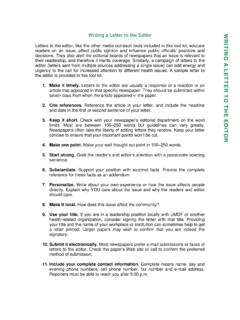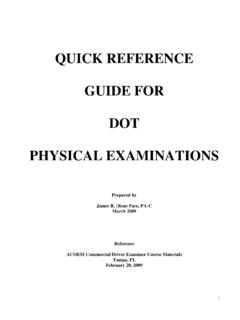Transcription of MITOCHONDRIA, THEIR STRUCTURE, FUNCTIONS, AND …
1 MITOCHONDRIA, THEIR STRUCTURE, FUNCTIONS, AND. DISEASES LINKED TO THE ORGANELLE. Introduction. Part structure of mitochondria. A). Morphology and organelle interactions. B). The fusion fission cycle of mitochondria. C). Internal structure. D). MtDNA, structure and packaging. E). Import of proteins into mitochondria. Part 2. Mitochondrial functioning in intermediary metabolism. A). Post-translational modifications control of Mitochondrial metabolism. B). Pyruvate dehydrogenase. C). Succinate dehydrogenase. D). The ATP synthase. Part 3. Mitochondria in apoptosis. Part 4. Control of mitochondrial levels: production versus destruction.
2 A). Biogenesis. B). Mitophagy. Part 5. Mitochondria in disease . A) Oxidative phosphorylation deficiencies. B). Fatty acid oxidation disorders. C). Mitochondria in the innate immune response. D). Mitochondria and cancer. E). Mitochondria and neurodegeneration. Parkinsons disease , Alzheimers disease , ALS, Huntingtons disease ). INTRODUCTION. Mitochondria are now known to be more than the hub of energy metabolism. They are the central executioner of cells, and control cellular homeostasis through involvement in nearly all aspects of metabolism. As our understanding of mitochondria has expanded it has become clear that the structure, function and pathology of the organelle are so intimately connected that it is difficult, if not impossible, to study any one area without context of the others.
3 Here is presented a relatively brief overview of the diverse areas of mitochondrial research to provide the background and stimulate the broad thinking that is needed to understand the role that mitochondria play in some of the more common and devastating human conditions including genetic mitochondrial cytopathies and neuropathies, Parkinsons and Alzheimers disease , diabetes and cancer. To facilitate easy reading, the number of citations is limited with the idea that readers can obtain details of specific areas through the key recent reviews listed. PART 1 THE STRUCTURE OF MITOCHONDRIA. A) MORPHOLOGY AND ORGANELLE INTERACTIONS.
4 The classic picture of cellular mitochondria based on low-resolution electron micrographs is of a set of relatively small bean shaped particles scattered around the cytosol. However, our understanding of the morphology of the organelle has changed with the advent of higher resolution electron microscopes and cryopreservation of samples. Foremost, mitochondria are now known to be highly dynamic and can be punctate as previously proposed, but can also be organized as a continuum or reticulum under some cell conditions. Further, the organelle moves within the cell in the punctate state or as a reticular unit to provide foci of energy production such as at the nucleus during cell division, or to synapses in neuronal cells at times of high information transfer.
5 This movement is along microtubules in one direction and along actin filaments in the other. Electron micrograph showing reticulum tubes . sectioned as they extend through the cytosol. From Gilkerson et al. FEBS Lett. 474 1-4 2000. 3D reconstruction of the mitochondrial reticulum fluorescently stained by matrix- localized GFP. High resolution of the GFP. labeled mitochondria showing the looping of the reticulum throughout its length. Several important studies have established that the switching between punctate and reticulum forms is physiologically important. For example it is cell cycle dependent, being reticular in the G1 phase but then converting to the punctate form for cell division.
6 The transitioning of mitochondria between punctate and reticulum states through alternating fission and fusion is now known to be critical to maintaining mitochondrial quality control. Fission allows separation of the healthy mitochondrial segments from the defective ones. Not surprising then, failure to transition between the different morphological forms is thought to contribute to several diseases Parkinsons disease : see later. Another aspect of mitochondrial organization that is now known to be important is the interaction between this and other cellular organelles including, endoplasmic reticulum, lysosomes and peroxisomes.
7 These interactions are labile and occur through contact sites involving proteins of the two organelles. Among key functions is the movement of Ca++ between mitochondria and ER and the co-ordination of the unfolded protein response by these two organelles. B). THE FUSION FISSION CYCLE OF MITOCHONDRIA. Mitochondrial fusion can be divided into two processes, the fusion of the mitochondrial outer membrane followed by that of the inner membrane. The outer membrane fusion requires proteins known as mitofusins, (Mfn1 and Mfn2). Inner membrane fusion mainly involves an inner membrane-localized protein (Opa1). The mitofusins are transmembrane dynamin-related GTPases, which induce the joining of 2 mitochondrial fragments by forming dimers across the interface.
8 The tethering of mitochondria together is followed by GTP hydrolysis, which induces conformation changes to cause mitochondrial fusion. The activity of mitofusins is regulated by ubiquitination, which causes THEIR degradation in response to stress. The control of this degradation involves several proteins (PINK1, Parkin, E3 ligase Huwe1, MULAN and Bcl-2 family members). The inner membrane protein Opa1 is named based on its identification as a mutated gene in optic atrophy. It is a dynamin- related GTPase that interacts with cardiolipin, a mitochondrial inner membrane lipid, and is mostly found in cristae, consistent with its role in maintaining cristae morphology.
9 Opa 1 is also found in the cytosol in lipid droplets. Opa1 activity involves the coordinated action of a long isoform of protein and its cleaved short isoform. The long isoform is located in the mitochondrial cristae membrane, while the short isoform is soluble in the intermembrane space. Opa1 proteolytic cleavage is regulated by the mitochondrial membrane potential, apoptosis, ATP. level and mtDNA stability. Mitochondrial fission involves another GTPase called Drp1. On translocation from cytosol to mitochondria, this protein oligomerizes into an X-shaped dimer on mitochondrial outer membranes. The binding sites for Drp1 association include endoplasmic reticulum (ER)-mitochondria contact points.
10 When localized to the mitochondrial outer membrane, Drp1 rims the mitochondria in multimeric spirals at the constriction site, with the GTPase domain pointing away from the membrane. Formation of a complete spiral is thought to activate the GTPase domain causing GTP hydrolysis leading to a spiral constriction. In apoptosis, Drp1 is also involved in Bax oligomerization on the outer membrane and in cytochrome c release. Functioning of Drp1 is controlled by post-translational modifications including phosphorylation by a signaling kinase (GSK3) and the post- translational modifications S-nitrosylation, ubiquitination, SUMO ylation and O-linked-N-acetyl-glucosamine glycosylation.

